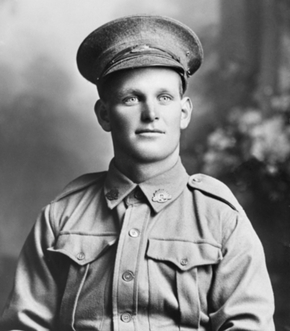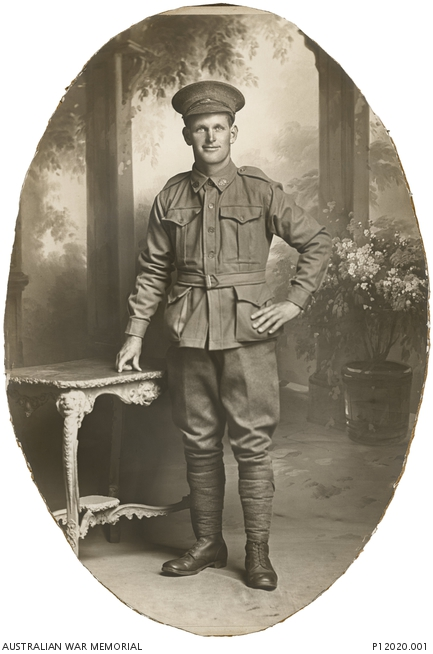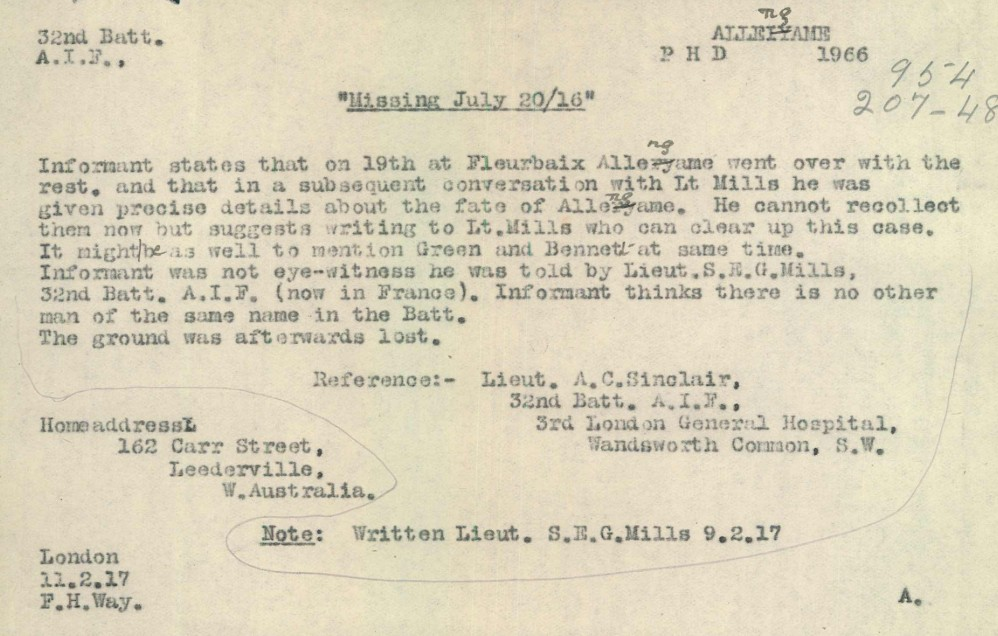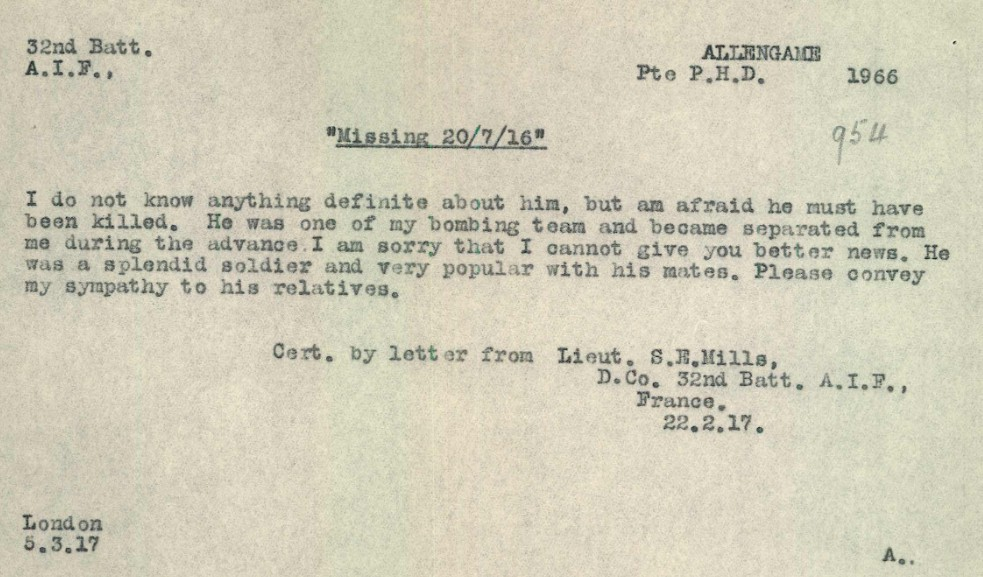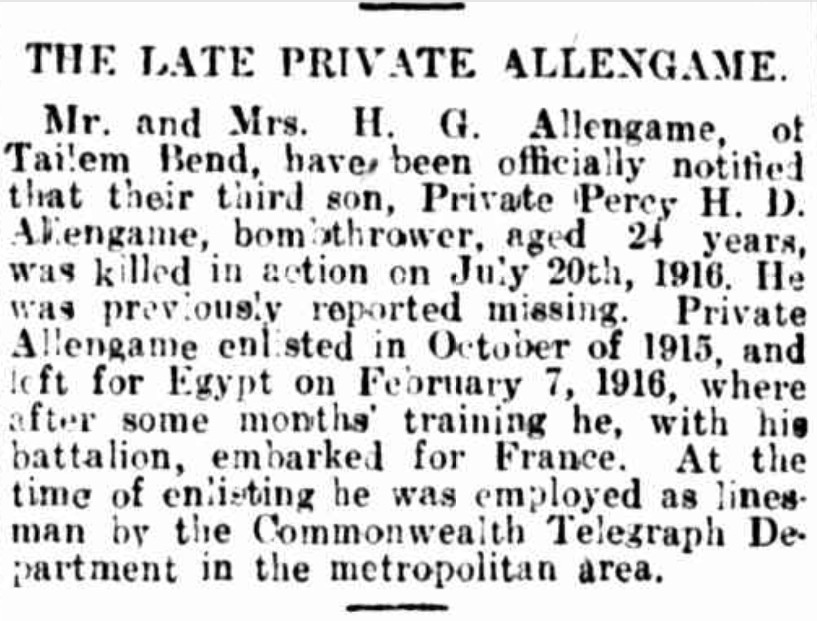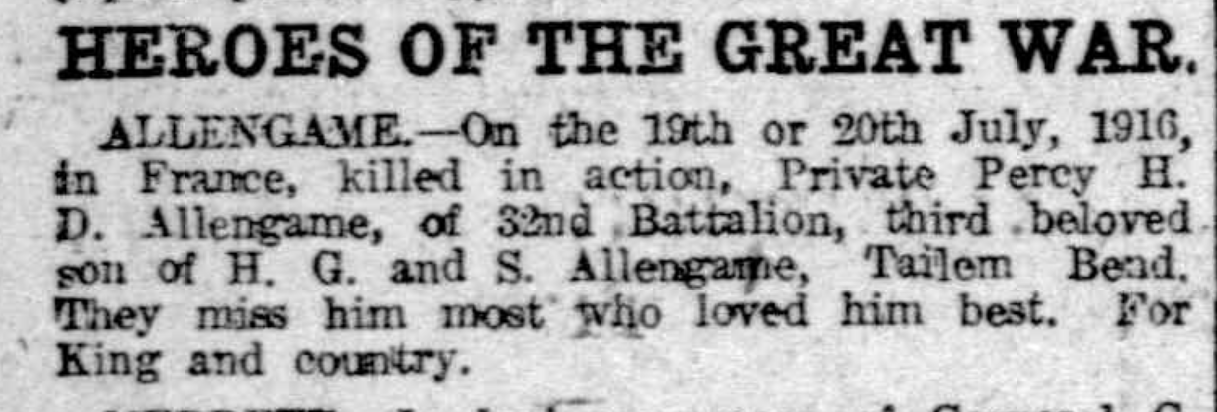Percy Henry David ALLENGAME
Eyes blue, Hair brown, Complexion fair
Percy Allengame – A Splendid Soldier
Can you help us identify Percy?
Percy Allengame’s body was never found after the Battle of Fromelles, and there are no records of his burial. A mass grave was found in 2008 at Fromelles, a grave the Germans dug for 250 Australian soldiers they recovered after the battle. As of 2024, 180 of these soldiers have been able to be identified via DNA testing. Percy may be among these remaining 70 unidentified men. There is still a chance to identify him — but we need help.
We welcome all branches of his family to come forward to donate DNA to help with his identification. See the DNA box at the end of the story for what we do know about his family. If you know anything of contacts for Percy, please contact the Fromelles Association.
Early Life and Family
Percy Henry David Allengame was born on 10 October 1891 in Macclesfield, South Australia, the fourth child of Henry George Allengame and Sarah Manning. His family included six siblings:
- John Edwin (1887–1963),
- Frederick William (1888–1970) AIF,
- Florence Annie (1890–1950),
- Mater May (1894–1975),
- Edith Jane (1897–1977),
- Walter George (1901–1994).
Percy grew up on his family’s farm between Tailem Bend and Coonalpyn and attended Cooks Plains and Coonalpyn Public Schools. Percy worked as a linesman for the Commonwealth Telegraph Department. Percy was a well-regarded member of the Tailem Bend community. He was a successful athlete, competing in cricket, football, foot races and cycling competitions. In 1911 and 1913 he was a regular competitor and winner at local sports meetings in Langhorne Creek and Tailem Bend. At a farewell social for the enlistees which was held on 22 November 1915, Percy was honoured alongside seven other local enlistees:
“The Institute Hall was not large enough to accommodate all who desired to attend the farewell social tendered to soldiers of the town and district who will be shortly leaving for the front.”
Off to War
Percy enlisted in the AIF on 4 October 1915 at Adelaide, South Australia. He embarked for active service on 7 February 1916 aboard HMAT A28 Miltiades, disembarking at Suez on 11 March. After training at Zeitoun with the 8th Training Battalion, he was taken on strength by the 32nd Battalion on 1 April 1916. The 32nd had been created in Australia in August 1915. It was made up of A and B Companies from South Australia and C & D Companies from Western Australia. As a ‘late’ add to the battalion, Percy was assigned to D Company while they were at the Duntroon Plateau camp.
After that, they were at Ferry Post until the end of May where they trained and guarded the Suez Canal. Their last posting in Egypt was a few weeks at Moascar. The call to support the British Expeditionary Force on the Western Front came in mid-June. The 32nd left from Alexandria on the ship Transylvania on 17 June 1916, arriving at Marseilles, France on 23 June 1916 and they then immediately entrained for a three-day train trip to Steenbecque. Their route took them to a station just out of Paris, within sight of the Eiffel Tower, through Boulogne and Calais, with a view of the English Channel, before disembarking and marching to their camp at Morbecque, about 30 kilometres from Fleurbaix.
Theodor Pflaum (No. 327) and Wesley Choat (No. 68) wrote about the trip:
“The people flocked out all along the line and cheered us as though we had the Kaiser as prisoner on board!!” – Theodore Pflaum
“The change of scenery in La Belle France was like healing ointment to our sunbaked faces and dust filled eyes. It seemed a veritable paradise, and it was hard to realise that in this land of seeming peace and picturesque beauty, one of the most fearful wars of all time was raging in the ruthless and devastating manner of "Hun" frightfulness”. – Wesley Choat
They were headed to the area of Fleurbaix in northern France which was known as the ‘Nursery Sector’ – a supposedly relatively quiet area where inexperienced Allied troops could learn the harsh realities of Western Front trench warfare against the Germans. But the quiet times did not last long. Training continued with a focus on bayonets and the use of gas masks, assuredly with a greater emphasis, given their position near the front. The 32nd moved to the Front on 14 July and they were into the trenches for the first time on 16 July, only three weeks after arriving in France.
The Battle of Fromelles
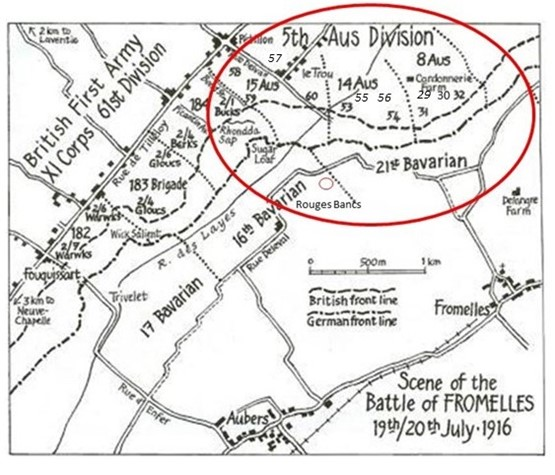
On the 17th they were reconnoitering the trenches and cutting passages through the barbed wire, preparing for an attack, but it was delayed due to the weather. Percy’s D Company’s Lieutenant Sam Mills’ letters home were optimistic for the coming battle:
“We are not doing much work now, just enough to keep us fit—mostly route marching and helmet drill. We have our gas helmets and steel helmets, so we are prepared for anything. They are both very good, so a man is pretty safe.”
The overall plan was to use brigades from the Australian Fifth Division to conduct a diversionary assault on the German trenches at Fromelles. The 32nd Battalion’s position was on the extreme left flank, with only 100 metres of No Man’s Land to get the German trenches. As they advanced, they were to link up with the 31st Battalion on their right. However, their position made the job more difficult, as not only did they have to protect themselves while advancing, but they also had to block off the Germans on their left, to stop them from coming around behind them.
On the morning of the 18th, A Company and C Company went into the trenches to relieve B and D Companies, who rejoined the next day. The Zero Hour for advancing from their front-line trenches was to be 5.45 PM, but the Germans knew this attack was coming and were well-prepared. They opened a massive artillery bombardment on the Australians at 5.15 PM, causing chaos and many casualties. The charge over the parapet began at 5.53 PM. A and C Companies were in the first and second waves to go, and Percy was in the third and fourth.
They were successful in the initial assaults and by 6.30 PM were in control of the German’s 1st line system (map Trench B), which was described as:
“practically a ditch with from 1 to 2 feet of mud and slush at the bottom”.
Unfortunately, with the success of their attack, ‘friendly’ artillery fire caused a large number of casualties because the artillery observers were unable to confirm the position of the Australian gains. They were able to take out a German machine gun in their early advances, but were being “seriously enfiladed” from their left flank.
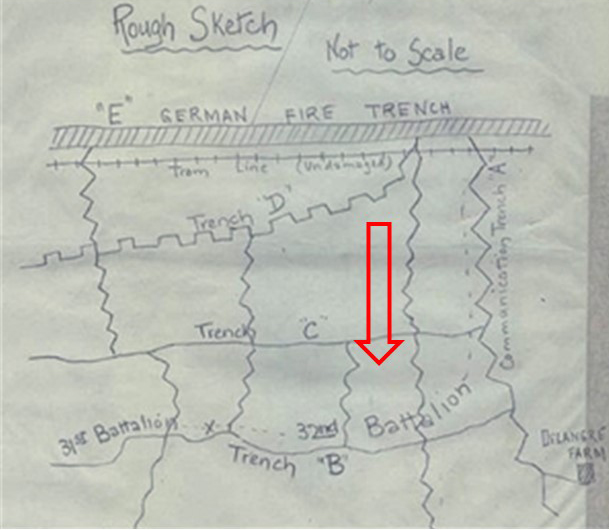
By 8.30 PM their left flank had come under heavy bombardment with high explosives and shrapnel. Return bombardment support was provided and the 32nd were told that “the trenches were to be held at all costs”. Source - AWM4 23/49/12, 32nd Battalion War Diaries, July 1916, page 12 Fighting continued through the night. The Australians made a further charge at the main German line beyond Trench B, but they were low on grenades, there was machine gun fire from behind them from the emplacement at Delangre Farm and they were so far advanced that they were getting shelled by both sides. In the early morning of the 20th, the Germans began a counterattack from the Australian’s left flank, bombing and advancing into Trench A (map).
Given the Australian advances that had been made earlier, the rear Trench E had been left almost empty, which then enabled the Germans to regain that trench and envelop the men of the 32nd. At 5.30 AM the Germans attacked from both flanks in force and with bombing parties. Having only a few grenades left, the only resistance they could offer was with rifles:
“The enemy swarmed in and the retirement across No Mans’ Land resembled shambles, the enemy artillery and machine guns doing deadly damage.”
What was left of the 32nd had finally withdrawn by 7.30 AM on the 20th. The initial roll call count was devastating – 71 killed, 375 wounded and 219 missing, including Percy. To get some perspective of the battle, when Charles Bean, Australia’s official war historian, attended the battlefield two and half years later, he observed a large quantity of bones, torn uniforms and Australian kit still on the battlefield.
The final impact was that 228 soldiers of the 32nd Battalion were killed or died from wounds sustained at the battle and, of this, 166 were unidentified.
Lieutenant Sam Mills survived the battle. In his letters home, he recalls the bravery of the men:
“They came over the parapet like racehorses……… However, a man could ask nothing better, if he had to go, than to go in a charge like that, and they certainly did their job like heroes."
Percy was posted as missing in action. It wasn’t until a Court of Enquiry held in August 1917 that formally declared his fate as ‘Killed in Action, 20 July 1916.’
Percy’s Fate
According to several witness statements, Percy died while in the thick of the advances that the 32nd had made.
Private Stephen Michael Redmond (1351), D Company, reported:
On July 19/16 at 8.30 p.m. dusk at Fleurbaix he saw Allengame last in No Man’s Land during an attack. At the beginning he was hit by shrapnel and killed.
Also, Private Cyril G.G. Smith (2111) noted that Percy’s body had not been recovered by the Australians:
`.`
On July 20th at Fleurbaix the Battalion made an attack on German Trenches at about 3.30 a.m. Informant was wounded and lying by the side of a shell hole in which he saw the body of Pte Allengame whom he knew well. This was between the German and English Trenches but nearer the English. The Germans counter-attacked but were in time unsuccessful. The body remained when Informant was picked up.
[[Source: SA Red Cross Wounded and Missing Files – Percy Allengame]]
Unfortunately, Cyril Smith subsequently died from wounds he sustained at the Battle. Sergeant Aubrey Sinclair (later Lieutenant) corroborated Percy had been killed, but his statement ALSO references Allan Bennett and Robert Green, who were seen together wounded in a shell crater and were so far forward that stretcher-bearers could not reach them. Both Bennett and Green were later recovered and identified in the mass grave at Pheasant Wood. Percy’s mention with these two might suggest that he may also lie there, still unidentified.
Another account by Lieutenant Sam Mills says he lost sight of Percy during the battle, but he described Percy as “a splendid soldier and very popular.”
After the Battle
His family placed notices in South Australian newspapers expressing their grief and gratitude to the Red Cross and Percy’s comrades.
Percy was awarded the Victory Medal, the British War medal, a Memorial Plaque and a Memorial Scroll.
He is commemorated at:
- Adelaide National War Memorial
- Adelaide Officers of S.A. Post, Telegraph and Telephone Department Great War Roll of Honor
- Adelaide Postmaster General's Department WWI Honour Board
- Australian War Memorial Roll of Honour
- Macclesfield ANZAC Memorial Gardens
- Tailem Bend and District Honour Roll
- V.C. Corner Australian Cemetery Memorial, Fromelles
Percy’s loss was deeply felt, especially by his older brother, Frederick William Allengame. Frederick had enlisted on 27 March 1916 — just months after Percy — and embarked from Adelaide aboard the Bulla on 24 June 1916, the same day Percy arrived at Fleurbaix. While Frederick was still at sea, his younger brother was killed in battle. Frederick was later assigned to the 32nd Battalion, the same unit Percy had served in, and was wounded four times during his service in France and Belgium.
Frederick was wounded in the face, chest, left thigh, and right thigh in separate incidents between 1916 and 1918, but survived the war. He returned to Australia in January 1919 and was welcomed home by the Tailem Bend community. Frederick married nurse Amy Hilda Delaine and settled in Murray Bridge as a dairy farmer. He later worked for the PMG — the same department Percy had worked for. Frederick served again during WWII and lived until 1970. His long life and quiet resilience stood in poignant contrast to the brother he lost.
Could Percy Still Be Found?
Percy’s remains were not recovered, he has no known grave. After the battle, the Germans recovered 250 Australian soldiers and placed them in a burial pit at Pheasant Wood. This grave was discovered in 2008 and since then efforts have been underway to identify these soldiers by DNA testing from family members. As of 2024, 180 of the soldiers have been identified, including 41 of the 166 unidentified soldiers from the 32nd Battalion, which include Alan Bennett and Robert Green who were fighting with Percy.
We welcome all branches of Percy’s family to come forward to donate DNA to help with his identification. Family members have come forward, but If you know anything of family contacts, please contact the Fromelles Association. We hope that one day Percy will be named and honoured with a known grave.
Please visit Fromelles.info to follow the ongoing identification project and Percy’s story.
Family Tree for Percy Henry David Allengame
| Soldier | Percy Henry David Allengame (1891–1916) – born Macclesfield, SA; died Fromelles |
| Parents | Henry George Allengame (1857–1931) and Sarah Manning (1860–post 1917) |
| Siblings | John Edwin (1887–1963) | ||
| Frederick William (1888–1970) | |||
| Florence Annie (1890–1950) | |||
| Mater May (1894–1975) | |||
| Edith Jane (1897–1977) | |||
| Walter George (1901–1994) |
| Grandparents | |||
| Paternal | Henry Scherrin and Jane Allingham (1848–1886) | ||
| Maternal | John Manning (1833–1911) and Mahala Howard (1838–1924) |
Links to Official Records
Seeking DNA Donors

Contacts
(Contact: carla@fromelles.info or geoffrey@fromelles.info).
(Contact: army.uwc@defence.gov.au or phone 1800 019 090).
Donations
If you are able, please contribute to the upkeep of this resource.
(Contact: bill@fromelles.info ).
